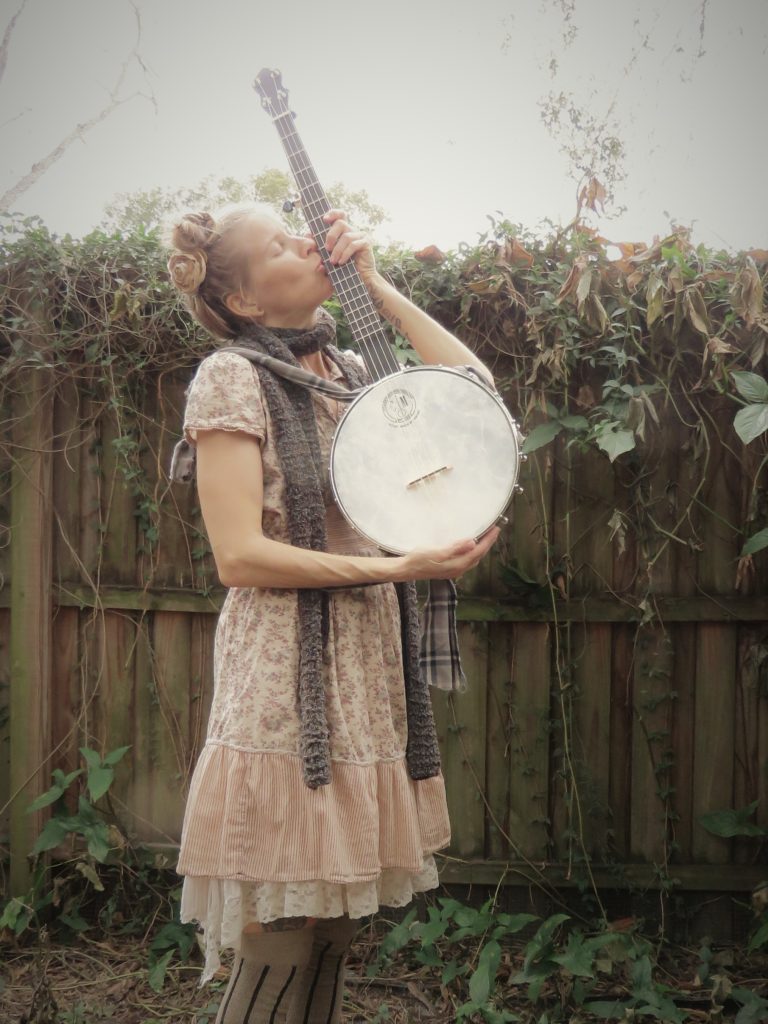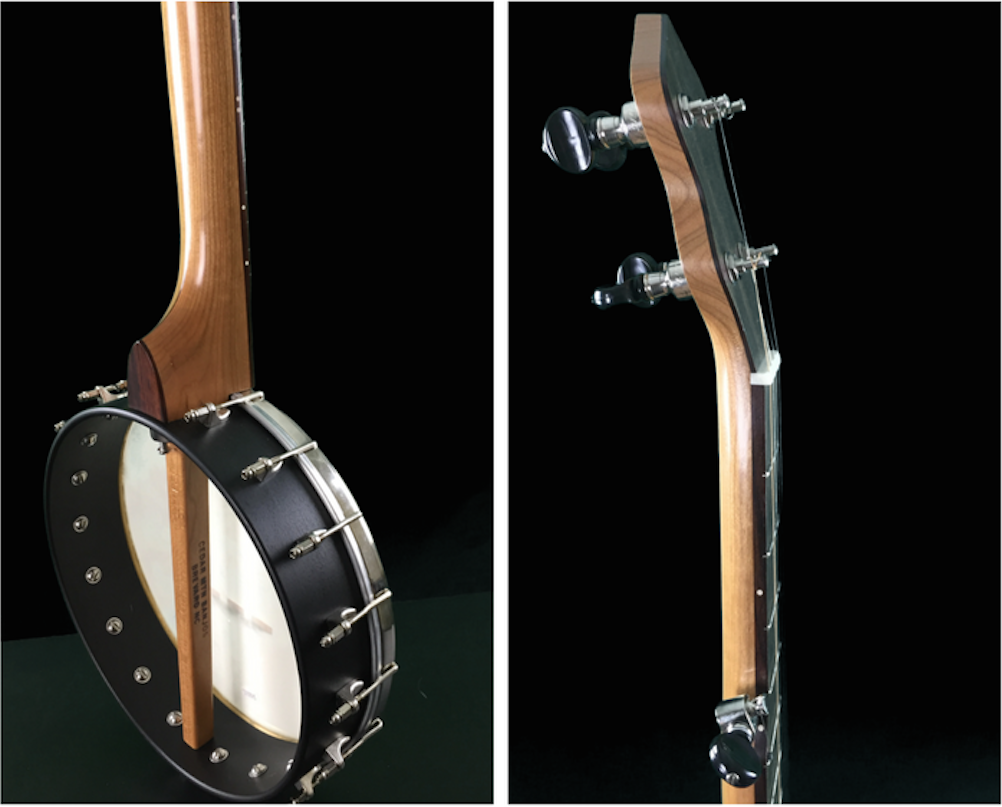The Origin Story
Like many banjo players who’ve been picking the five for any significant length of time, I’ve developed a fairly specific idea of the things I want in a banjo. In particular, a very specific idea of the sound I want out of a banjo.
And with so many talented builders making banjos these days, it’s easier than ever to pursue that sound.
Over the years, I’ve gone through quite a number of banjos in my quest to find my sonic holy grail. Each iteration seemed to bring me a bit closer to what I was after.
Then one day while browsing around YouTube, I heard it. A banjo with “the sound.”
Just the right mix of sustain, decay, and note separation. Round and bright, without being harsh or metallic. And nicely balanced across the frequency spectrum.
The banjo was a Cedar Mountain, an L1 model to be precise.
This one wasn’t for sale, nor was I in a position then and there to acquire a new banjo, so I filed it away for the future.
A year or so later, however, an opportunity to acquire one presented itself, and I pounced. I would have to purchase it without first playing it, so was of course a bit apprehensive.
Plus, I’d built it up so much in my mind, what were the chances it’d live up to my expectations? I braced myself for a let down.
It wasn’t long before I knew I’d made the right call. If anything, it sounded better than I’d imagined.
A few months later another Cedar Mountain came up for sale, this one in their “Jubilo” line. A different model, but at a great price. What the heck. Worst case scenario I can sell it for what I bought it for, I figured.
I tuned it up, played it, and it still had that same magic. Even though the components weren’t the same in this model, all those qualities that I value most were still there.
I was impressed. These banjos were clearly the product of a gifted and meticulous maker, one who obsesses over the finer points of tone as much as I do.
It also seemed as if there must be some special convergence between my particular banjo tastes and sensibilities and those of Cedar Mountain.
I would later learn that the maker behind these banjos, second-generation builder Tim Gardner, is both a professional musician and self described “audio nerd.” As a fellow self described “audio nerd,” our tonal convergence now made sense.
A “banjo player’s banjo”
I’ve long had in mind an idea for a “banjo player’s banjo.” A banjo that could serve equally well as someone’s first upgrade from an entry level banjo OR as an expert’s “main player” in their banjo stable. And a banjo in which the resources of time, expertise, and raw materials have been marshaled primarily into the service of tone, playability, and versatility.
As far as looks are concerned, it needed to honor the banjo’s tradition and form, but with a minimum of bling. Beautiful simplicity is what I was after.
Don’t get me wrong – imaginative and pretty inlay has its place, but I wanted a banjo that screams “play me,” not “look at me.”
In other words, I wanted a banjo with the most tonal bang for the buck possible.
Here were the constraints I had in mind:
- Top quality components and tone woods
- Handmade with expert craftsmanship, fit and finish, with specific attention and care to those aspects that contribute to tone and responsiveness
- A design that highlights the simple beauty and clean, elegant lines of the banjo
- Ability to accommodate a wide range of tonal “voices” based on setup
- Imminently playable (comfortable and responsive)
- and a frailing scoop, of course…
After my experiences with my two aforementioned Cedar Mountain banjos, who better to bring this concept to life than Tim?
So we fleshed out the details and Tim made it happen.
When the first prototype came, I was beyond delighted. I won’t say too much more, but will let your ears be the judge (sound clips below). I’ll only add that I’ve noted my other banjos are starting to get jealous (it doesn’t hurt that this banjo is super light, making it very easy to tote from room to room!). 🙂
So….what’s the name of this banjo, you ask?
Come on, that part was easy.

THE SPECS for “The Brainjo”
- 3-piece cherry neck with matching dowel, ebony fingerboard and peghead overlay
- maple thin rim, 11″
- 25.5″ neck scale
- 2-way adjustable truss rod
- frailing scoop
- high-quality nickel hardware and tuners
- bone nut, 1 5/16″ width
- side dots at frets 1, 3, 5, 7, 10, 12, 15, and 17
THE SOUND – Choose Your Brainjo’s Voice”
We all have our preferences when it comes to tone. In part because of what we like to hear. In part because of the particular kind of music we want to make on our instrument.
And, as mentioned, I wanted a banjo that could produce a variety of desirable “voices,” based on its set up.
And so as one of its unique features, the Brainjo will come set up to maximize whichever voice you choose.
Choose from 3 different possibilities, which I think are representative of most often desired for sonic qualities in the world of clawhammer banjo (and since you may desire adjust the voice yourself, you’ll also receive a guide to how to change its setup to achieve a particular voice).
The 3 voices of the Brainjo are, based on the setup you choose, are:
VOICE #1: The “Tommy”
The “Tommy” is the base setup, and best for all around traditional banjo playing.
The setup: Renaissance head, steel strings.
The sound: Plenty of brightness to cut through the mix of a jam session, with a tone that’s ideally suited to traditional settings. Great note separation, moderate sustain, and little bit of crunchiness to the tone. Perfect for doing justice to notey fiddle tunes, and for driving a string band.
Who’s it for: Folks who like the music and aesthetics of old time, and who will be spending their time playing the music of that repertoire. Great for playing solo, in jams, fiddle-banjo duets, or old time string bands.
VOICE #2: The “Hobart”
Equipped with a brass tone ring, the “Hobart” is for those who both love the traditional banjo repertoire, but who also enjoy spreading their wings into other styles and genres (or who just like a little extra shimmer to their sound).
The setup: Fiberskyn head, brass tone ring, steel strings.
The sound: Similar in tonality to the “Tommy,” but not as crunchy, with an extra bit of shimmer and sustain. Great for cutting through a mix, and for enhancing the background “atmosphere.”
Who it’s for: Folks who like the traditional sound and repertoire, but who also may enjoy playing more contemporary music on the banjo, or for playing in band settings outside of the old-time sphere. Also great for playing and singing, as its enhanced sustain helps provide a thicker “atmosphere” behind the voice.
This setup also gives a fantastic sound for old time fingerstyle banjo.
*** – the “Hobart” is my own personal preference for the Brainjo’s setup
VOICE #3: The “Roscoe”
The “Roscoe” those who want a sound that stays rooted to the mountains.
The setup: Fiberskyn head, nylgut strings.
The sound: the “plunkiest” version of the 3 available voices. Less bright with more low end and the least amount of sustain of the three.
Who’s it for: For those want a banjo that sounds like it’s from the mountains, and evokes a simpler time. Its deeper tones and machine gun like note separation make it an ideal complement to the fiddle. Best suited for solo playing on the back porch (old dog not included), traditional songs with sparser backup styles, and fiddle-banjo duets.
Here’s a visual representation of where each of these voices resides on the banjo sound spectrum:


The Verdict?
When I played the first prototype of the Brainjo from Tim, I thought the combination of lightness, tone, and playability was too good to be true (and tried to restrain myself when talking about it!). Because of that, I find myself reaching for it at every chance.
Now that we’ve released multiple Brainjos out in the world, I’m delighted to report that it appears that fellow Brainjo owners agree with me:
“Got the Brainjo, have played it all week. This is the best playing, sounding banjo I have ever had. I have four banjos, one that cost over twice that yours did, and this is better.”
– Steve S., Brainjo Owner
“This is love at first sight: the tone I wanted, simple but gorgeous design and craftsman, and a delight to play.”
– Steve B., Brainjo Owner
“I don’t need any more time with my Hobart to make my report. It has taken first position in my collection. Its got the tone and ease of play that comprise my major criteria of banjo goodness. The light weight and good looks are added pluses. Terrific banjo!
“It’s even better than you described. The sound is just outstanding and, for my taste, a tiny bit of stuffing…makes it perfect. It is, in every way a joy to play. Hard to put it down!”
– Howard R. Brainjo Owner
“Just stopped playing it long enough to send you a huge thank you for the”Tommy” banjo. Got it via UPS this afternoon. Beautiful — love the feel and balanced weight of it, the smooth wood neck, the Elite head. Your setup is awesome – bright/crisp enough to be heard and still has an old-timey sound, especially at the scoop, yet I’ll be able to play w/BG over the head.”
– Sue B., Brainjo Owner
“Appreciating more every day the setup and qualities of this Brainjo…love it! Thank you again. You’ve created a monster now…I have played and listened to clawhammer for years, however it’s become a passion recently due to the accessibility of your videos/listening vault and to having a great banjo to play.”
– Dustin R., Brainjo Owner
“The Brainjo sounds AMAZING! I am so excited to play it learn more songs and tunes. This banjo is inspirational. Thank you!”
– Cal S., Brainjo Owner
“…my Brainjo banjo has changed (and improved) my playing immensely. The instrument is much lighter and more agile than my [other banjo] on which I started. I look forward to playing her and spend at least an hour each day playing.”
– David L., Brainjo Owner
From the Banjo Hangout:



HEAR IT FOR YOURSELF:
Below are samples of both the “Tommy” and “Hobart” voices (“Roscoe” to follow soon), in various tunings (for the pot stuffers out there, samples of the “Tommy” with stuffing in the back of the pot are also provided):
The Brainjo Sound Samples
And here are a couple of recent videos with the “Tommy” and “Hobart” setups:
WARRANTY & SUPPORT There is a lifetime warranty for materials and workmanship to the original owner. THE PRICE Price is $1500 for “Tommy” and “Roscoe” setups, $1550 for “Hobart” (for the addition of the brass ring). All Brainjo banjos are shipped in a TKL hard case at the discounted price of $150. $300 is due at the time of pre-order, and the remainder (to include shipping) will be collected prior to shipment. RETURN POLICY Full refund (minus shipping costs) if returned within 7 days.
Orders for The Brainjo banjo are currently closed.
